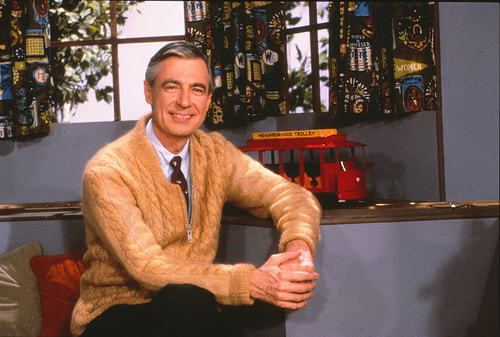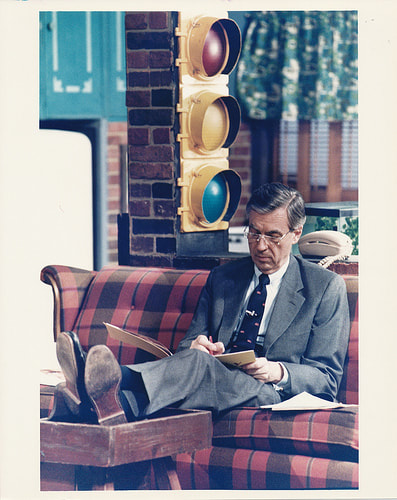Archived Blogs
|
Everyone knows Fred Rogers (aka Mister Rogers). But after reading about his background and accomplishments, I wanted to know…how did he become the man he was? And then I found a copy of one of his letters listing ten books that influenced him. Here’s the list:
You can read my first blog here. A couple of comments first. You’ll see that Rogers wrote ‘the writings of..’ Well, Henri Nouwen wrote 39 books. Ouch. I only read two of this books (full disclosure) but I think I’ve figured this out nonetheless. To start with, I had to remind myself that Fred Rogers was an ordained minister of the Presbyterian church…and he considered his entire viewing audience as his congregation. Some claim that when he said “Hello, neighbor” at the introduction of each show, he was referencing the second commandment to “Love thy neighbor as thyself.” So what does this have to do with Henri Nouwen? When I look for spiritual help…I go to church. But where does a minister go? Fred Rogers would have wanted and needed a mentor too…someone who could dive deeper into religious topics, help address the dilemmas and struggles that are part of being in the ministry. Someone to help him stay strong in his mission. I believe that’s who Nouwen was to Fred Rogers. Over 7 million copies of Henri Nouwen’s books have sold and they’ve been published in 30 languages. He was a priest, a teacher, an author and a public speaker. Nouwen is considered one of the most spiritual leaders of our time. What was different about his writings that might have appealed to Rogers? Nouwen was transparent about his own trials and tribulations—he often spoke of his own feelings of depression and loneliness—giving hope to those that had the same feelings. As ‘one of the flock’ we assume that religious leaders have all the answers but that’s not true, they’re searching too… Aren’t you like me, hoping that some person, thing or event will come along and give you that final feeling of inner well-being you desire? (Life of the Beloved) His work had to be refreshing to any minister that experienced self-doubt or spiritual exhaustion. In fact, it’s said that Nouwen’s ‘weakness was his strength”... There was a time when I really wanted to help the poor, the sick, and the broken, but to do it as one who was wealthy, healthy, and strong. Now I see more and more how it is precisely through my weakness and brokenness that I minister to others. His books aren’t for everyone. Life of the Beloved was written for the secular (non-religious) world but a friend of Nouwen’s told him, “You are not aware of how truly secular we are…” and “you speak from a context and tradition that is alien to us.” (Life of the Beloved) Reading his books was like listening to a sermon specifically designed for a priest…or a minister. Like Fred Rogers. Whew. I’m ready for something lighter now. Like #4 - The Secret Garden… p.s. Fred Rogers was often scorned for some of his overly-obvious statements such as “I’m feeding the fish now” said while he sprinkled food over the fish tank each day. He starting saying that in response to a letter he received from a mother. She told him that her daughter was worried that the fish might be hungry. He was talking…reassuring… a blind girl. photo from PBS.org #thanksmisterrogers
0 Comments
Everyone knows Fred Rogers (aka Mister Rogers).
But after reading about his background and accomplishments, I wanted to know…how did he become the man he was? And then I found a copy of one of his letters listing ten books that influenced him. Here’s the list.
So I decided to check it out. You can read my first blog here. I was a bit taken aback to see a psychology text book listed as the second book. I’d learned about Erik Erickson when I was in medical school. He wrote about developmental stages in children. But he wasn’t the only one. We had several psychologist that outlined important stages of development such as Jean Piaget or BF Skinner. So why him? First, I looked at his stages again. Here are some of his early stages and a very brief description:
So, I took a step back and did a bit of detective work. That’s when I think I figured it out. Fred (I’m tempted to call him Mister Rogers out of respect) was in seminary when he received some advice to take a specific course. A child development course. It was taught by Dr Margaret McFarland. Dr MacFarland was a co-founder of the Arsenal Family and Children’s Center. Other participants included the famous Dr Benjamin Spock and Dr Erik Erickson. So it’s likely he was introduced to Dr Erickson through Dr MacFarland. But here’s the even more interesting part. The whole field of child development was emerging in the middle of the twentieth century and Fred Rogers was right in the epicenter. And why is that a big deal? Prior to this idea of developmental stages, it was not real clear how a person developed into who they were. Maybe you got your red hair from your mom and your temper from your dad? But according to this new literature, going through these stages was a necessary part of our maturation. And if we don’t succeed in mastering a stage, it could have a permanent effect on our lives. Do you know what happened? Fred looked at television designed for children and knew that it needed to be better. He purposefully designed his show around this new information with a goal of helping these children through important stages of development. His show was designed for ages 2.5-5.5 which spanned three of Erickson’s stages. (I would argue that he also provided “consistent, predictable, reliable care in their relationships in order to develop trust” just in case any younger toddlers were watching. Fred had an opportunity to influence (in a positive fashion) millions of children and he took on that responsibility and treated it with the importance that it has. How do I know that? He met with Dr. Margaret McFarland weekly and spoke with her on the phone almost daily—touching on subjects for the show and how to approach them. An article by Sally Ann Flecker discusses their working relationship and the remarkable attention to detail they used on the show. Some of the details that I found interesting: At the start of every show, Mister Rogers enters his house by walking in the door, which is on the left of the viewer’s screen, and moving to the right. This is how children’s eyes will track when they learn to read. The show’s unhurried pace, in marked distinction from most contemporary children’s programs, allows children the chance to process what is being presented, the opportunity to make connections, and the space to concentrate. Mister Rogers often turns to the camera to talk to children—looking right into the television audience for what, to adults, might seem uncomfortably long. For children, though, the eye gaze mimics their earliest interactions with their parents and provides a supportive moment. The trolley serves as a transition. It brings viewers into the show and ferries them from Mister Rogers’ house to the Neighborhood of Make-Believe and back safely to Mister Rogers again. It also gives young children, who are concerned when parents leave, practice with issues of disappearance and reappearance. So, I came to realize that this book was his instruction manual for how to gently guide a child through important developmental stages…crucial for becoming a well-adjusted adult. And then I realized that we all have that duty and with each interaction we have with a child we can either help…or hurt that process. I need to remember that. On to book three. photograph from PBS.org. #thanksmisterrogers Everybody knows Mister Rogers.
He was born in 1928 and died the morning of February 27, 2003 with his wife by his side. Despite being soft-spoken and unassuming, he attracted the attention of millions of viewers over the course of his career. To say he was beloved would be an understatement. Reading an account about his life on Wikipedia is humbling. He spent his life in service to others—whether it was writing a book to help a child after the death of a pet or advocating for 20 million dollars in support for the PBS by insisting that public television provided both social and emotional education critical for a child’s development. So I wondered, how did Mister Rogers become the man he was? Fred Rogers was known to be an avid reader so that’s where I started. I googled ‘books that influenced Mister Rogers’ and found a letter he’d written. Ten books were listed. He wrote that he considered the Bible the greatest of the books. Here’s the list.
So if the Bible was the greatest, why wasn’t it at the top? If this list were written by anyone else, I wouldn’t question it, but Fred Rogers was quite purposeful in his actions. So I thought about that first book... Le Petit Prince (The Little Prince) is hard to define. It’s about a pilot that crashes in the Sahara and meets a Little Prince. The Prince describes his love for a rose, his visits to other planets and meeting a fox. While written like a children’s book, adults can appreciate the lessons from the narrator of the story. Some readers claim that it’s a book about war, while others state that it’s about the creativity of childhood. I think each reader gains different insights and my suspicion is that the lessons learned vary according to the circumstances you find yourself in at the time. So with repeated readings… you may actually experience a different insight each time. And that reminded me of the Bible. Jesus didn’t pass out the Hebrew Bible to the crowds of people searching for answers—he started by telling parables... just like “Le Petit Prince”. What if the list is building up to the Bible? Maybe Mister Rogers left us a path to follow—I’m going to find out. Some of my favorite quotes from Le Petit Prince are: All grown-ups were once children…but only a few of them remember it. The most beautiful things in the world cannot be seen or touched, they are felt with the heart. A rock pile ceases to be a rock pile the moment a single man contemplates it, bearing within him the image of a cathedral. It is such a mysterious place, the land of tears. You can find the book The Little Prince here. Photograph from PBS.org #thanksmisterrogers The silence of my sister’s house after her daughter died was interrupted by the constant chime of her daughter’s phone. It gave me an uncomfortable feeling realizing the her friends were trying to reach her and didn’t know that she died. But days later, when the chime frequency rose instead of falling, I realized that they knew Rachel was dead and they were reaching out to her anyway… So I wondered, what were those friends of her saying? Were they distraught and seeking comfort? Mad that Rachel had died? Frustrated about some unfinished business? And I wondered… have we always tried to talk to our loved ones after they’ve died? We have. There are fifteen letters written as early as 2686 BC to relatives that had recently died. They were found on linen, papyrus and even written in wooden bowls. The geographic spread of where these messages were discovered suggests that it was usual to communicate with the dead in this fashion. What is really interesting about these ancient letters is the content of them. They have the tone of a letter written to your relative who just got that promotion at work…mostly pleas to intervene for circumstances such as disputes over property or ill health. These letters don’t express sorrow at the absence of a loved one, it’s as if their relatives are still part of their lives. This is fascinating to me because it gives strong evidence of their assumption of life after death. You can read more about these letters here. More recent letters, typed instead of written on linen, portray our confusion and loss. In a letter from 1946, a husband tells his wife that he finds it “hard to understand in my mind what it means to love you after you are dead”. But it’s very clear he does…he speaks of meeting other women but that they “all seem ashes” and closes his letter proclaiming “…I do adore you.”
We’ve gone beyond typewriters and now you can post your letter to your loved one online. Websites like aftertalk.com offer grief blogs and inspirational quotes, grief counseling resources and the ability to have private conversations with friends and family. One beautiful website, Letters to the Dead is a “place to say what needs to be said…to those who are not here physically.” Letters are posted that allows the writer an opportunity for closure-- “I had to leave north before you left us, and because of that I couldn’t properly say goodbye. That still eats at me, a year and half later. I miss you. I wanted to say goodbye.” Sometimes they express anger-- “I always thought I’d see you again, when we were old and gray and it couldn’t hurt any more. People in your family didn’t die young, after all. Your much older sisters are both alive, 10 years after your death. Damn it, Doug. Damn it. I always thought I’d see you again.” Some give you a glimpse of the pain when you lose your child-- “I miss the hot press of you against my chest in the night, after reading stories of trucks, after singing silly songs, after endless rocking. There was always a moment when you finally gave in to sleep, when you tucked your head into my breast, wrapped your arms around my neck and tangled your hands so thoroughly in my curls that later, after I’d woken, I had to untangle us like a knot.” I wish for two things. I hope these letters give the writers some solace. I believe that there is life after death and I hope that, like ancient times, these writers recognize that our loved ones will always be a part of our lives. A tremendous book!
Format: Paperback|Verified Purchase I love this book! If you love unicorns and adventure – or even just adventure – then this is a book that you will love, too! While The Oath: Mirabella and Connery is the third book in Susan Badaracco’s The Oath series, each one can easily be read as a stand-alone novel (however, having read the previous two books I will say that the knowledge of the characters gleaned from those books greatly enhances your enjoyment of the subsequent books). Mirabella is determined to protect her cousin, TJ, after he has a terrifying encounter in the woods on a class field trip. Connery, a magnificent chestnut unicorn with a Scottish accent and a tragic past, is determined to protect Mirabella, having sworn an oath to defend her from harm. Together, Connery and Mirabella find themselves fighting against the unicorns’ terrifying enemies to keep the unicorns and humans safe. This book is a fantastic read that grabs you from the first page and gallops to a strong and intriguing finish. |
Archives
October 2020
Categories |
COPYRIGHT 2017 SUSAN BADARACCO | Site Credits








 RSS Feed
RSS Feed